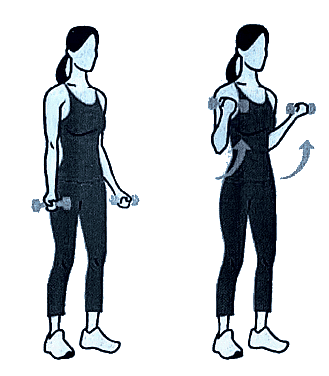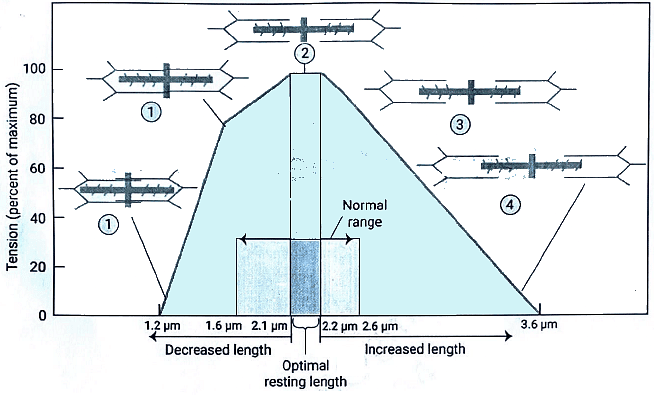UPSC Exam > UPSC Notes > Medical Science Optional Notes for UPSC > Modes of Contraction in Skeletal Muscle
Modes of Contraction in Skeletal Muscle | Medical Science Optional Notes for UPSC PDF Download
| Table of contents |

|
| Introduction |

|
| Sliding filament Theory |

|
| Isotonic vs Isometric contractions |

|
| Length Tension Relationship In Skeletal Muscle |

|
| Excitation-Contraction coupling |

|
Introduction
As organs that contain cells that can contract, muscles can generate force and movement. Skeletal muscle works in conjunction with the bones of the skeleton to create body movements. Additionally, it is also associated with the diaphragmatic, esophageal, and eye muscles. Thus, skeletal muscle serves a variety of purposes, including moving of the body, breathing, and swallowing. In contrast to both smooth muscle and cardiac muscle, skeletal muscle contracts primarily in response to a voluntary stimulus.


Sliding filament Theory

Isotonic vs Isometric contractions
Isometric Contraction:
- Muscle Length: Does not shorten.
- Force Application: Contracts against a force without changing length (fix length).
- Joint Movement: Does not involve joint movement.
- Tension: Increases, but no work is done (static).
- Energy Efficiency: More energy-efficient with less release of heat.
- Examples:
- Maintaining posture (e.g., standing against gravity).
- Pushing against a wall.
Isotonic Contraction:
- Muscle Length: Shortens.
- Force Application: Shortens against a fixed load.
- Joint Movement: Involves joint movement.
- Tension: Constant during shortening.
- Work Done: Work is done (dynamic).
- Energy Efficiency: Less energy-efficient with more heat release.
- Examples:
- Body movements (e.g., walking).
- Lifting heavy weights.
Additional Notes:
Duration:
- Isometric contractions are often of short duration.
- Isotonic contractions may involve longer durations.
Mechanical Elements:
- Isotonic contractions involve the shortening of contractile elements along with the contribution of elastic and viscous elements.
Question for Modes of Contraction in Skeletal MuscleTry yourself: Which type of muscle contraction involves joint movement and shortening of the muscle?View Solution
Length Tension Relationship In Skeletal Muscle

Excitation-Contraction coupling

Contraction

The document Modes of Contraction in Skeletal Muscle | Medical Science Optional Notes for UPSC is a part of the UPSC Course Medical Science Optional Notes for UPSC.
All you need of UPSC at this link: UPSC
|
7 videos|219 docs
|
FAQs on Modes of Contraction in Skeletal Muscle - Medical Science Optional Notes for UPSC
| 1. What is the sliding filament theory? |  |
Ans. The sliding filament theory is a theory that explains how muscle contraction occurs. According to this theory, muscle contraction is the result of thin filaments sliding past thick filaments within the muscle fibers. When a muscle contracts, the thin filaments, composed of the protein actin, slide towards the center of the sarcomere, overlapping with the thick filaments, composed of the protein myosin. This sliding action shortens the sarcomere, resulting in muscle contraction.
| 2. What is the difference between isotonic and isometric contractions? |  |
Ans. Isotonic contractions are muscle contractions where the muscle changes length, either shortening or lengthening, while exerting force. In isotonic contractions, the tension developed by the muscle remains constant throughout the contraction. Examples of isotonic contractions include lifting weights and walking.
On the other hand, isometric contractions are muscle contractions where the muscle does not change length but generates tension. In isometric contractions, the muscle fibers generate force without any movement in the joints. An example of an isometric contraction is when you try to push against an immovable object, such as a wall.
| 3. What is the length-tension relationship in skeletal muscle? |  |
Ans. The length-tension relationship in skeletal muscle refers to how the force generated by a muscle fiber depends on its length. It states that the maximum force is generated when the muscle fiber is at an optimal length. If the muscle fiber is too short or too stretched, the force generated decreases.
When the muscle fiber is at an optimal length, there is maximum overlap between the thin and thick filaments, allowing for the optimal formation of cross-bridges between actin and myosin. This results in the maximum force generation. If the muscle fiber is too short, there is limited overlap, reducing the force generated. If the muscle fiber is too stretched, there is also limited overlap, reducing the force generated.
| 4. How does excitation-contraction coupling occur in skeletal muscle? |  |
Ans. Excitation-contraction coupling is the process by which an electrical signal (action potential) is transmitted to the muscle fibers, leading to muscle contraction. It involves the coordinated interaction between the nervous system and the muscle fibers.
When a motor neuron is stimulated, it releases the neurotransmitter acetylcholine at the neuromuscular junction. Acetylcholine binds to receptors on the muscle fiber, causing depolarization of the muscle membrane. This depolarization propagates along the muscle fiber membrane, triggering the release of calcium ions from the sarcoplasmic reticulum.
The released calcium ions bind to troponin, causing a conformational change in the troponin-tropomyosin complex. This exposes the active binding sites on the actin filaments, allowing myosin heads to bind and form cross-bridges. The myosin heads then undergo a series of chemical reactions, resulting in the sliding of the thin filaments past the thick filaments and muscle contraction.
| 5. What are the different modes of contraction in skeletal muscle? |  |
Ans. There are two main modes of contraction in skeletal muscle: concentric and eccentric contractions.
Concentric contractions occur when the muscle shortens while generating force. This is commonly seen when lifting a weight or performing a bicep curl. During concentric contractions, the force generated by the muscle is greater than the external load, resulting in muscle shortening.
Eccentric contractions, on the other hand, occur when the muscle lengthens while generating force. This is commonly seen when lowering a weight or lowering oneself down from a pull-up bar. During eccentric contractions, the force generated by the muscle is less than the external load, resulting in controlled muscle lengthening. Eccentric contractions are particularly important for activities such as running downhill or lowering heavy objects, as they help to control and decelerate movement.

|
Explore Courses for UPSC exam
|

|
Signup for Free!
Signup to see your scores go up within 7 days! Learn & Practice with 1000+ FREE Notes, Videos & Tests.
Related Searches
















